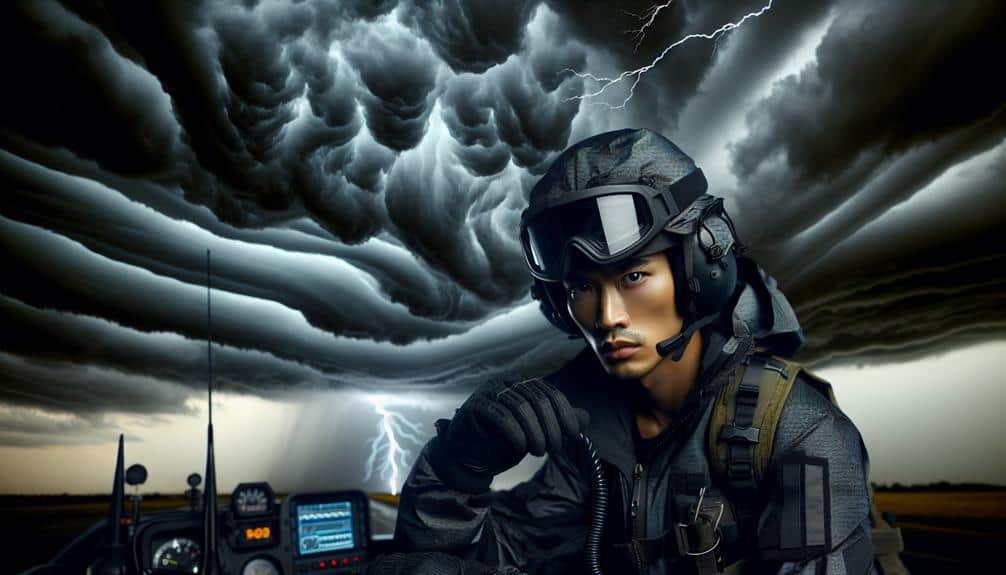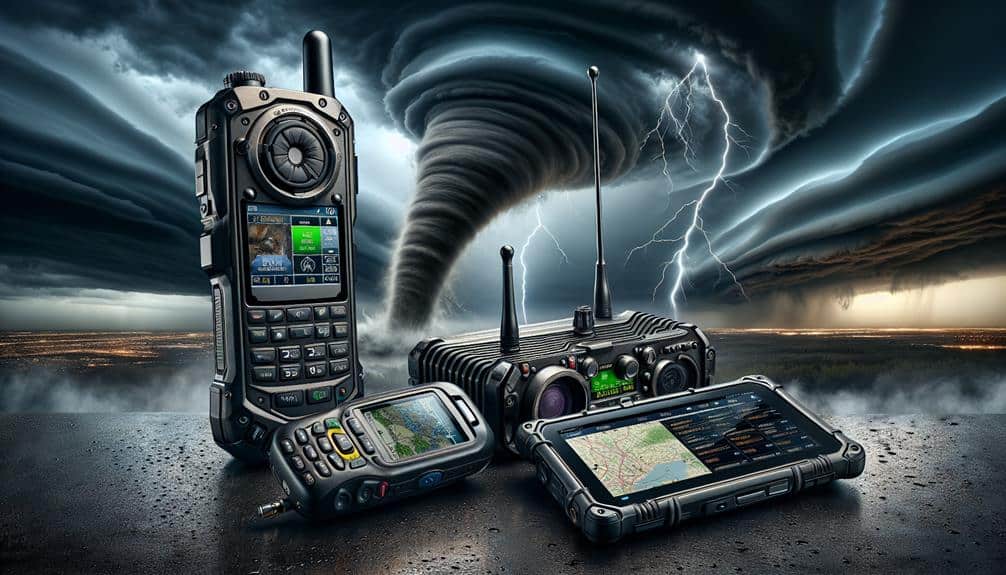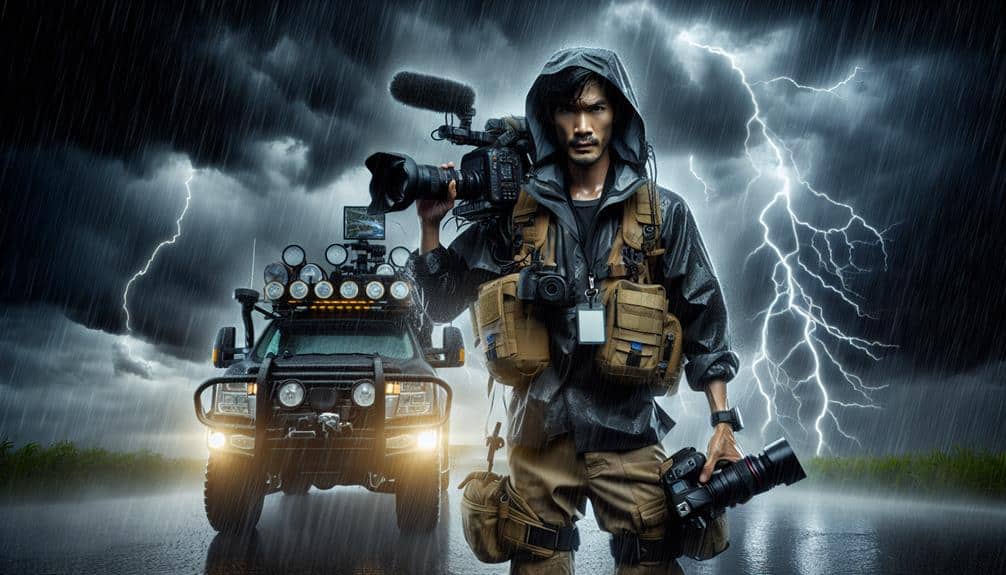When we venture out for storm chasing, we prioritize safety by using top-tier gear. Our list begins with a durable storm chasing vehicle, featuring reinforced structures and advanced guidance systems. We rely on reliable weather radios for real-time updates. High-quality protective clothing, including waterproof layers and insulated undergarments, is essential. Sturdy helmets and goggles protect us from debris, while our first aid kit handles emergencies. We also use emergency communication devices like satellite phones and two-way radios. Ultimately, GPS navigation systems ensure we remain on track. By understanding each item's importance, we can explore how they work together effectively.
Key Points
- Durable Storm Chasing Vehicle: Reinforced structures, advanced guidance systems, and off-road capabilities ensure safety and mobility.
- Reliable Weather Radio: Provides real-time storm tracking, GPS functionality, and specific area alerts with SAME technology.
- High-Quality Protective Clothing: Includes breathable, waterproof outer layers, insulated undergarments, and durable footwear for comprehensive protection.
- Sturdy Helmet and Goggles: Impact-resistant materials and anti-fog coatings protect against debris and allow clear vision.
Durable Storm Chasing Vehicle
A durable storm chasing vehicle must be equipped with reinforced structures and advanced guidance systems to guarantee safety and reliability in extreme weather conditions. We need to prioritize vehicle maintenance to ensure the engine and all mechanical components perform at their best. Routine checks on tire pressure, oil levels, and brake functionality are non-negotiable.
Safety features such as roll cages, reinforced windows, and advanced seatbelt systems are essential to protect us from potential impacts.
When traversing treacherous terrain, off-road capabilities become essential. Four-wheel drive systems and high ground clearance allow us to cross muddy fields and rugged backroads without getting stuck. The vehicle must also be equipped with reliable suspension systems to handle the unpredictable nature of storm-chasing environments.
Storage solutions play an important role in keeping our equipment organized and accessible. Customizable racks and secure compartments allow us to stow cameras, weather instruments, and emergency supplies efficiently. Proper weight distribution within the vehicle ensures stability, particularly when we need to make quick maneuvers.
Reliable Weather Radio
In maintaining our awareness of rapidly changing weather conditions, a dependable weather radio is essential for efficient storm chasing. In the midst of severe weather, real-time information is our lifeline, and it's pivotal for precise storm tracking and timely emergency response. A top-tier weather radio guarantees we receive the latest alerts from the National Weather Service, even when cellular networks fail.
We should prioritize models that feature SAME (Specific Area Message Encoding) technology. This allows us to program alerts for specific regions, enhancing our capability to focus on relevant storm developments. Additionally, a weather radio with a hand-crank or solar power ensures continuous operation, even in prolonged power outages.
Advanced weather radios also integrate GPS functionality, giving us precise location-based alerts. This feature is crucial for tracking storm paths in real-time and adjusting our course to maintain safety and maximum observation potential. A built-in NOAA weather band ensures we're tuned into the most reliable sources for updates.
Durability and water resistance are non-negotiable, considering the harsh conditions we often face. By equipping ourselves with a sturdy, multi-functional weather radio, we notably enhance our storm tracking capabilities and emergency response readiness, making sure we stay one step ahead of nature's wrath.
High-Quality Protective Clothing
When it comes to high-quality protective clothing, we should focus on three crucial areas: waterproof outer layers, durable footwear choices, and insulated undergarment options.
Each of these components plays an essential role in ensuring our safety and comfort during storm chasing.
Let's analyze how these elements contribute to our overall preparedness.
Waterproof Outer Layers
For best storm chasing, investing in high-quality waterproof outer layers is vital to stay dry and protected. When we're out in the thick of a storm, we need gear that not only keeps water out but also allows our bodies to breathe. This is where breathable rainwear comes into play. Materials like Gore-Tex or eVent offer the dual benefits of waterproofing and breathability, ensuring we don't get soaked from rain or sweat.
Layering options are essential for adapting to varying weather conditions. We should start with a moisture-wicking base layer to keep sweat off our skin. Next, an insulating middle layer, like a fleece or lightweight down jacket, helps retain body heat. Finally, our outer shell must be fully waterproof and windproof yet breathable. This three-layer system provides the flexibility to add or remove layers as the weather changes.
We must prioritize jackets and pants with sealed seams and adjustable cuffs to prevent water ingress. Hoods with brims and adjustable drawstrings enhance head protection, ensuring we maintain clear visibility.
Durable Footwear Choices
Choosing the right durable footwear is vital for maintaining safety and comfort while storm chasing. We need footwear that can handle extreme conditions while protecting our feet. Breathable boots are a top choice, offering a balance between ventilation and protection. These boots prevent overheating and moisture buildup, which is pivotal when on the move for extended periods.
In addition, let's not overlook the importance of waterproof socks. They provide an essential layer of protection against wet conditions, ensuring our feet stay dry even if water seeps through our footwear. Waterproof socks are particularly useful when paired with breathable boots, creating a dual-layer defense against the elements.
For added stability on slippery or uneven terrain, traction cleats are indispensable. They attach easily to our footwear, providing enhanced grip and reducing the risk of slips and falls.
Durable sandals can also serve us well during less intense conditions. They offer breathability and comfort while still providing robust construction to withstand rough environments. However, it's vital to pair them with waterproof socks to maintain dry feet.
Insulated Undergarment Options
While our footwear choices guarantee stability and protection for our feet, insulated undergarments are equally important for maintaining core body warmth in harsh storm conditions.
When it comes to high-quality protective clothing, thermal base layers and insulated socks are non-negotiable components of our gear.
Thermal base layers, typically made from materials like merino wool or synthetic fibers, provide essential insulation by trapping body heat. These layers are designed for moisture-wicking, guaranteeing that sweat doesn't compromise our warmth. We need to select base layers that offer a snug fit without restricting movement, facilitating both comfort and efficiency.
Insulated socks are another vital element. Constructed from advanced thermal fabrics, these socks keep our feet warm and dry, even in the most challenging weather. They often feature reinforced areas to reduce wear and tear, extending the lifespan of our gear. The combination of high thermal retention and breathability makes these socks indispensable.
As storm chasers, we must prioritize garments that enhance our mobility and endurance. Well-chosen thermal base layers and insulated socks not only protect us from the elements but also secure we remain agile and focused.
Let's invest in these crucial pieces to maximize our performance and safety.
Sturdy Helmet and Goggles
When storm chasing, we must prioritize wearing a sturdy helmet and goggles to protect against flying debris and harsh weather conditions. A helmet designed specifically for impact resistance is critical. It should be constructed from high-quality materials such as polycarbonate or Kevlar, ensuring it can withstand the force of objects propelled by high winds.
Additionally, integrating helmet cameras allows us to document our experiences while keeping our hands free for other essential tasks. These cameras should be lightweight and securely mounted to avoid adding undue stress or becoming a hazard themselves.
Equally important is the use of impact-resistant eyewear. Goggles made from durable, shatterproof materials like polycarbonate lenses offer the best protection. They need to fit snugly, sealing out wind and debris while providing clear visibility. Anti-fog coatings and ventilation systems in the goggles can further enhance our ability to see in challenging conditions.
First Aid Kit
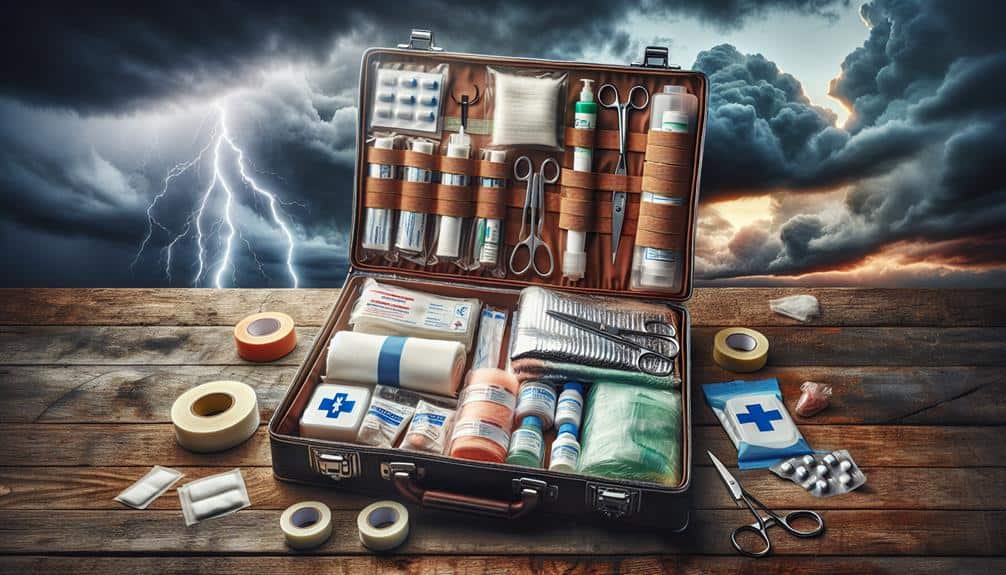
Ensuring we've a complete first aid kit is vital for addressing potential injuries during storm chasing. A well-stocked kit enables us to handle minor injuries and stabilize more serious conditions until professional help arrives.
The key components of our first aid kit should include adhesive bandages, antiseptic wipes, gauze pads, adhesive tape, and a digital thermometer. Additionally, we must have sterile gloves, scissors, tweezers, and a CPR face shield.
Emergency supplies like pain relievers, antihistamines, and burn ointments are essential for immediate relief. Including a compact first aid manual ensures we can follow the correct procedures under pressure. By regularly checking and replenishing our kit, we confirm all items are in usable condition and within their expiry dates.
Safety precautions dictate that we should be prepared for various scenarios. For instance, in the event of a severe cut or sprain, we can use the elastic bandage and cold pack to manage swelling and pain.
Our commitment to having a complete first aid kit underscores our dedication to safety and preparedness. These measures not only protect us but also empower us to embrace our freedom to explore the most extreme weather phenomena responsibly.
Emergency Communication Devices
In addition to our first aid kit, reliable emergency communication devices are essential for maintaining contact and accessing help during storm chasing expeditions. These devices guarantee that we're never entirely cut off, even in the most remote and hazardous environments.
Here are four essential options:
- Satellite Phones: Unlike mobile phones, satellite phones provide coverage virtually anywhere on the planet. They're important for areas where cell service is unreliable or non-existent. With a satellite phone, we can make calls, send texts, and sometimes even access basic internet services.
- Emergency Beacons: These devices, such as Personal Locator Beacons (PLBs) and Emergency Position-Indicating Radio Beacons (EPIRBs), send a distress signal to search and rescue services. They work by transmitting our GPS location to a network of satellites, making them crucial for rapid response in life-threatening situations.
- Two-Way Radios: For short-range communication, especially within a team, two-way radios are highly effective. They allow us to coordinate movements and share real-time information about storm developments.
- Mobile Weather Stations: Portable weather stations can transmit real-time data about our immediate environment, including wind speed, humidity, and temperature. This information can be essential for making quick, informed decisions during a chase.
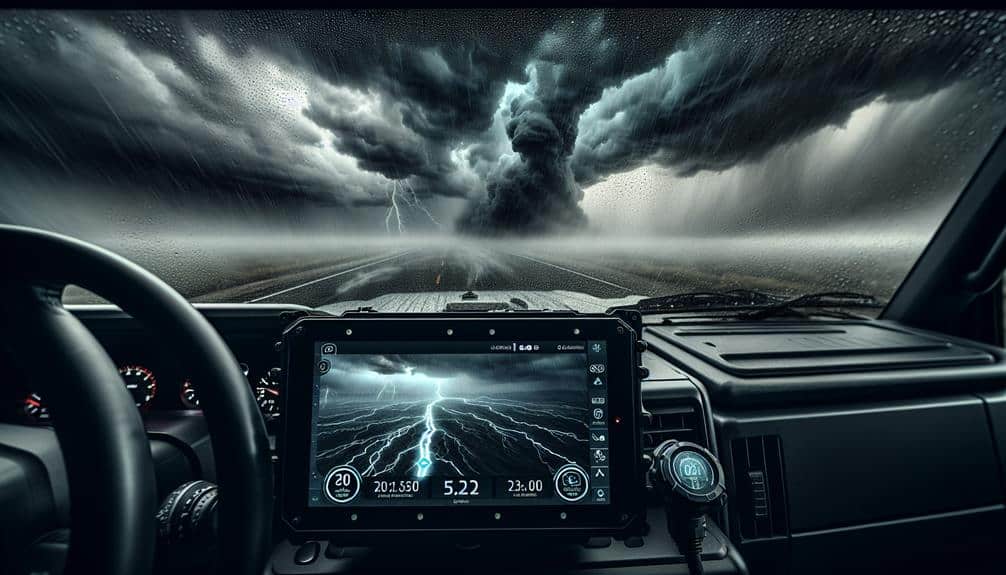
GPS navigation systems provide us with precise, real-time location data, which is essential for safely navigating through severe weather conditions during storm chases. These systems leverage satellite tracking to guarantee we can pinpoint our exact location and route, even when traditional landmarks and roads might be obscured by the storm. This level of accuracy helps us avoid the most dangerous sections of the storm and find the quickest routes to safety.
Modern GPS devices are equipped with emergency beacons, which can be lifesaving. If we find ourselves in a perilous situation, activating these beacons sends our exact coordinates to emergency responders, ensuring a prompt rescue. This function is vital when cellular networks fail, a common occurrence during severe weather events.
Additionally, advanced GPS systems offer real-time updates on weather conditions, road closures, and alternative routes. This dynamic data allows us to make informed decisions on the fly, maintaining our freedom to chase storms while prioritizing safety.
Frequently Asked Questions
How Can I Stay Informed About Real-Time Storm Updates While Chasing?
We stay informed about real-time storm updates by using weather radios, monitoring social media, and subscribing to emergency alerts. Additionally, we regularly check reliable weather websites for the latest information and forecasts while chasing.
What Are Essential Items to Keep in a Storm Chasing Emergency Kit?
Balancing thrill with safety, we should pack emergency shelter, communication devices, food, and water provisions. Staying connected and secure guarantees our freedom to chase storms without compromising our well-being. Preparedness transforms risk into adventure.
Are There Specific Apps Recommended for Storm Chasers?
For emergency communication and weather tracking apps, we recommend RadarScope for real-time radar data, Storm Shield for severe weather alerts, and Zello for walkie-talkie functionality. These tools guarantee we stay informed and connected during storm chases.
How Do I Ensure My Camera Equipment Is Safe During a Storm?
To safeguard our camera equipment's safety during a storm, we should use waterproof cases for best camera protection and explore equipment insurance. Coverage options will provide financial security if our gear gets damaged.
What Are the Best Practices for Storm Chasing in Rural Areas?
Did you know over 60% of storm chasers experience vehicle breakdowns? We need to prioritize vehicle maintenance and guarantee robust emergency communication systems. Regular checks and reliable radios enhance our safety and freedom while chasing storms.
